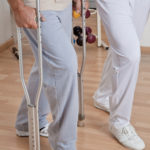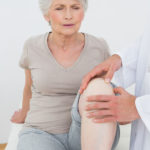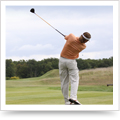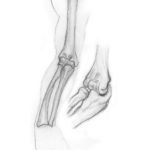Catherine Logan, MSPT
Article Archive
Fitness professionals may work in concert with a physical therapist to encourage a client to engage in “prehab” to maintain or enhance his strength preoperatively for knee or hip arthroplasty. (Shakoor et al. 2010). Pain is often a limiting factor, and it may be difficult for the client to participate in even the most basic daily activities. Below are a few suggested exercises.
KNEE ARTHROPLASTY
Isometric quadriceps sets. Lie on back with legs extended. Tighten quads and push knee into mat/surface. Hold 10 seconds. Do 10 repetitions, 5 times per day.
Mr. Brown is a 68-year-old retired postal worker who stays active with golf and tennis, but he complains of severe pain and swelling in his left knee, which he cannot straighten completely. The pain limits his ability to do the things he loves, but he is otherwise comfortable during daily activities. Based on X-rays and a clinical exam, Mr. Brown has symptomatic knee osteoarthritis.
Read MoreIf you’ve worked with golfers (or those who aspire to play), you know the game is not just for leisure seekers. Golf requires force, flexibility and control. Golfers can benefit greatly from working with a Pilates professional who understands not only how the body works but how the right movements address specific needs on the green.
Read MoreIf you’ve worked with golfers (or those who aspire to play), you know the game is not just for leisure seekers. Golf requires force, flexibility and control. In addition to the sheer physicality involved in carrying a heavy golf bag for 18 holes and leaning over dozens of putts each fairway outing, the actual swing is a delicate balance between freedom of movement and body control. Golfers can find great benefit from working with a Pilates professional who understands not only how the body works but how the right movements address specific needs on the green.
Read MoreWouldn’t it be great to know exactly what your clients want and need from you? If you are like most Pilates studio owners, you probably can’t invest a lot of money in complex statistical computer models or market research to gather data about your clientele. However, you should still collect this information on your own. For gathering data about your customers and their programming needs, there are many vehicles, including focus groups, experimental research or questionnaires.
Read Moreimg src=”/files/article_images/20…
Read MoreYou can probably remember studying for
your certification exam: What is the difference between a strain and a sprain?
a tendon and a ligament? an artery and a vein? the sympathetic and the
parasympathetic nervous systems? After the exam was over, you probably used or
heard these words yet forgot the exact medical definitions, the precise
functions or even the distin…
Running places extraordinary demands on an athlete’s body. Injuries can happen in many places, including the feet, shins, knees and hips. Designing a program that helps runners avoid or recuperate from common injuries is a great way to market your services. This month’s column will focus on three injuries that runners frequently encounter: iliotibial band syndromeli…
Read MoreRunning places extraordinary demands on an athlete’s body….
Read MorePREVENTION
&
POSTREHAB
BY CATHERINE LOGAN, MSPT
The Scoop on Running Injuries
Help runners to avoid common injuries–and to cope with them when they do occur.
Running places extraordinary demands on an athlete’s body. Injuries can happen in many places, including the feet, shins, knees and hips. Designing a program that helps runners avoid or recuperate from common injuries is a great way to ma…
Falls can be serious at any age, often causing ligamentous sprains or injury to bones and soft tissue. In addition, the inevitable decrease in overall physical activity during the recovery period can lead to other unfavorable consequences. The temporary inactivity may be a minor setback for young people, but for seniors it can result in losses in muscle mass, endurance and functional rang…
Read MorePREVENTION
&
POSTREHAB
BY CATHERINE LOGAN, MSPT
A Fall Prevention Program
The right exercise program can reduce older adults’ risk of falling and help prevent potentially catastrophic injuries.
Falls can be serious at any age, often causing ligamentous sprains or injury to bones and soft tissue. In addition, the inevitable decrease in overall physical activity during the recovery period can lea…
Anatomy Review
The elbow is a “hinge” joint formed by the distal end of the humerus and the proximal ends of the radius and ulna bones. The elbow moves into flexion and extension. The trochlea and capitulum of the humerus articulate with the trochlear notch of the ulna and the radial head, respectively.
The specific articulations of the elbo…
img src=”/files/article_ima…
Read MorePREVENTION
&
POSTREHAB
BY CATHERINE LOGAN, MSPT
Fairway Safety and Performance
Design a conditioning program that will prepare the golfer’s body for the stresses of the sport.
The popularity of golf has soared in recent years. It is no longer a sport just for retirees and “snowbirds” headed south for the winter. Golfers range from every-sooften players to seasoned professionals. Unfortunately, …
img src=”/files/article_images…
Read MoreFront ViewBack Viewhumerusolecranon
processInside Viewlateral epicondyle of humerusOutside Viewhumerushead of radiusmedial
epicondylecapitulumproximal
radioulna…
img src=”/files/article_ima…
Read MorePREVENTION
BY CATHERINE LOGAN, MSPT
&
POSTREHAB
Repetitive Stress Injury: The Upper Trapezius
Whether your clients are sports participants, musicians or simply casual computer users, they may suffer from this common condition.
Repetitive stress injuries (RSIs)–sometimes referred to as “repetitive strain injuries”–are a group of conditions usually caused by placing too much stress or strain on…
img src=”/files/article_images…
Read More





